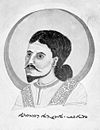The Epistles
The Epistles is one of the Seven Treatises of Manichaeism. It is derived from the Middle Ancient Persian dēwān, which means "Letter Collection".[1] They have been long known among Manichaean scriptures[2] They were originally written during the years of Mani’s public mission in the Sasanian Empire (ca. 240-276 C.E.). They were collected together by his followers and became one of the canonical books of the Manichaean community[3] It served a purpose of explaining the doctrine[4] and arguing for the correctness of Manichaeism[5]
Scripture content[edit]
This scripture is collectively referred to as the "Collection of Letters". The titles of 76 letters are listed in Ibn Nadim 's "Study of Groups of Books". The writers included Mani and his successors. The format of Mani's letters is very similar to that of St. Paul’s, because Mani took the form of Paul in the new era.
Sealed Letter[edit]
The most famous of the Manichaean letters is the Letter of the Seal, which Mani wrote to his followers from prison before his death. This letter is read by Manichaeans every year during the Feast of the Holy Throne. The closing part of the letter in Old Persian is preserved in the Manichean Prayer and Confession Book read by Hennings.
"...From my most beloved son Mar Ammo, from the dear children who are with me. To all priests, bishops and apostles, to all religious and lay people, to brothers and sisters - great and small, pious, perfect, righteous people, to all who have received the Gospel from Me, who rejoice in My precepts and good works, and who are firm in faith and have no doubts. Greetings to all of you."[6]
Coptic text[edit]
In Egypt, some Coptic translations of some epistles were found, but the whereabouts of these translations are unknown during WWII. In the documents found in Kellis, fragments of a collection of letters were also found. Gardner published three fragments of letters:[2]
"Mani, the Apostle of the Holy One Jesus Christ, and all the brethren who are with me - To so-and-so, and all the brethren who are with you. The Holy Father and our Lord Jesus Christ give peace to you, my beloved brother; it will protect your body and your soul."
"I feel I should write a long letter, but these young people you send find out how much pain I am in. I am seriously ill and not getting better, and this is probably the worst illness I have had in thirty years. Therefore I was unable to write, so I dictated to these young men what I wanted to write, and they relayed it to you. Your heart is grieved by the words of your sick brethren, and mine is overwhelmed with great sorrow. My son, I have written to you these 'ten sayings', which soothe your heart. I myself endure pain, but I still give comfort to my child. These words that I heard in the midst of my illness, you too must accept them with joy and certainty. You are to understand them."
"Our Lord Jesus Christ said, 'He who eats with me kicks me with his feet,' and this will be done to me. The same is true of me, and these will happen to me. He who eats with me at the table, wearing my clothes, kicks me with his feet, just as an enemy does with its enemies. From My children and disciples I suffer this affliction, and it is I who deliver them from the bondage of this world and the flesh - it is I who save them from the death of this world! In this generation I have encountered and endured all this from all people."
Paraphrase in Latin and Chinese[edit]
In addition to daily church business, some of Mani's letters are also expositions of doctrine. In Augustine's Latin writings, more than ten fragments of Mani's Fundamental Letters are preserved. These fragments mainly expound on the diachronic trinitarian doctrine of how this world was created.
Parts of this scripture are also quoted in the Dunhuang document "Incomplete scripture of Manichaeism": "The Nimman Sutra says: 'If the Dana do not have the good dharma, the pure light, the vigorous wisdom and benefit are all ready in the body, that is, the new man, with all his merits and virtues."[7]
See Also[edit]
References[edit]
- ↑ G. Haloun &. W. B. Henning, "The Compendium of the Doctrines and styles of the Teaching of Mani, the Buddha of Light", p, 205-207.
- ↑ 2.0 2.1 Gardner, Iain (2001-01-01). "The Reconstruction of Mani's Epistles from Three Coptic Codices (Ismant el-Kharab and Medinet Madi)". The Light and the Darkness: 93–104. doi:10.1163/9789004439900_007. ISBN 9789004439900.
- ↑ Gardner, Iain (2013-12-01). "Once More on Mani's Epistles and Manichaean Letter-Writing". Zeitschrift für antikes Christentum/Journal of Ancient Christianity. 17 (2): 291–314. doi:10.1515/zac-2013-0015. ISSN 1612-961X. Unknown parameter
|s2cid=ignored (help) - ↑ G. Haloun &. WB Henning, "The Compendium of the Doctrines and styles of the Teaching of Mani, the Buddha of Light", p, 205–207.
- ↑ Mary Boyce, "The Manichaean Literature in Middle Iranian", p. 69.
- ↑ Mary Boyce, " The Manichaean Literature in Middle Iranian", pp. 69-70.
- ↑ "Jing Zang" (4), Bei Dun 00256, Yu 56, 18/7, page 360 next
Script error: No such module "AfC submission catcheck".
This article "The Epistles" is from Wikipedia. The list of its authors can be seen in its historical and/or the page Edithistory:The Epistles. Articles copied from Draft Namespace on Wikipedia could be seen on the Draft Namespace of Wikipedia and not main one.

